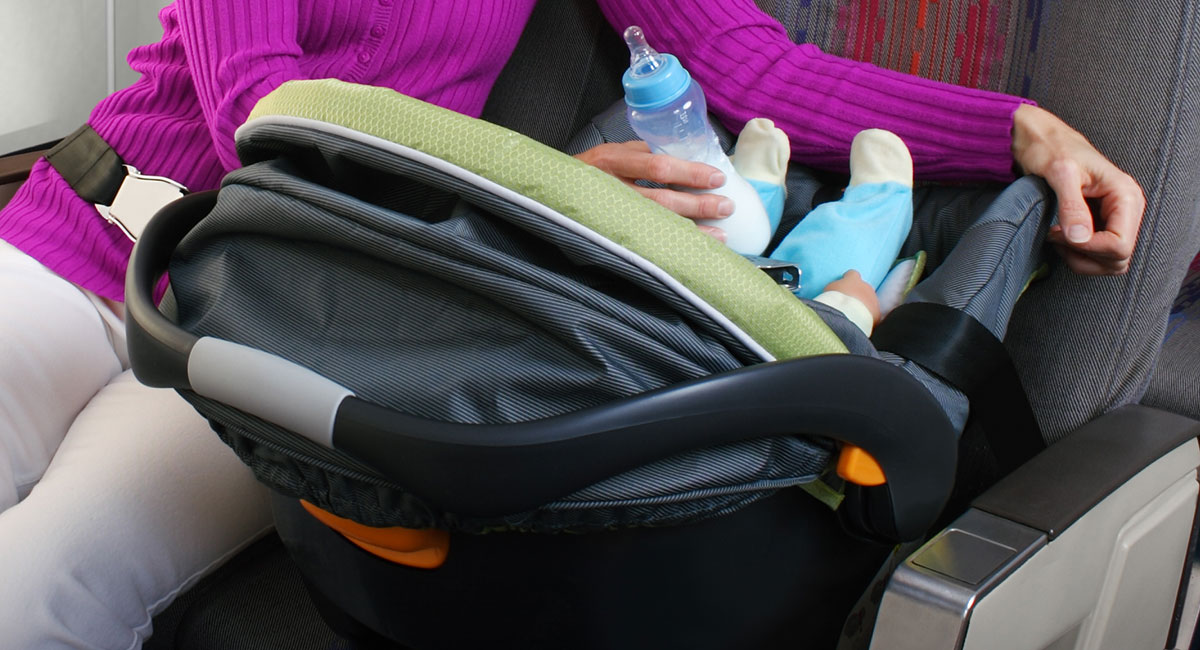Can a Two Month Old Baby Fly on an Airplane
By: Claire McCarthy, MD, FAAP
Taking a baby on a plane is something that most parents approach with trepidation—with good reason.
Babies and air travel can both be unpredictable, and they don't always mix well. But some advanced planning and preparation can help make for a better experience for your baby, for you, and for everyone else on the plane.
| In this article, the American Academy of Pediatrics (AAP) answers some common questions you may have before traveling with your baby and offers tips for a smoother and safer flight. |
|---|
When is my baby old enough to fly on an airplane?
Generally, it is discouraged for babies to fly unnecessarily shortly after birth. Air travel increases a newborn's risk of catching an infectious disease. Babies born prematurely, with chronic heart or lung problems, or with upper or lower respiratory symptoms may also have problems with the change in oxygen level within the air cabin. Parents should talk with their child's pediatrician before flying.
If there is a measles outbreak in your area, or you plan on traveling somewhere where there is a measles outbreak, your pediatrician may recommend your baby receive an extra dose of the MMR vaccine. This may be given as early as 6 months of age. Learn more here.
Does my baby need a passport for international travel?
Yes. All U.S. citizens, including infants, need a current passport to travel internationally. Parents or guardians need to apply with their baby in person using the form DS-11. Be sure to bring your baby's birth certificate and a photo taken within the last 6 months.Passport photos must be taken with nobody else in the photo, which can be tricky with infants. To do this safely if your baby can't sit up yet, theU.S. Department of State recommends laying your baby on her back on a white blanket or sheet to ensure head support without having to hold her. Another option is covering a car seat with a plain white sheet and taking a picture of your child while she sits in it.
What about domestic flights?A valid passport is usually the only identification your baby will need to fly on a domestic flight, unless you need to show proof of age for a discounted child fare. Check with your airline before you leave. Note: Children under age 18 will not be required to get a Real ID. |
|---|
Should my baby sit on my lap during the flight?
Ideally, no. The FAA doesn't require a ticket for children under the age of 2 years, but that means your baby will be on your lap. If there is turbulence, or worse, you may not be able to protect your baby in your arms. If you do not buy a ticket for your child, ask if your airline will allow you to use an empty seat. If your airline's policy allows this, avoid the busiest days and times to increase the likelihood of finding an empty seat next to you.
The safest way for baby to fly: |
|---|
Should I bring our car seat on the plane with us? Does that count as luggage?

Car seats, booster seats, and strollers generally don't count as luggage, but policies vary by airline; check with yours before flying. In most cases they can be checked at the gate, where the risk of damage is lower, at no cost. If your baby has his or her own airplane seat, bring your car seat with you.
Not all car seats are certified for use in airplanes.Make sure a label on the car seat says: "This restraint is certified for use in motor vehicles and aircraft." |
|---|
Which seat on the plane is best for a baby?
-
Look for rows on the plane with more space, like the bulkhead. Exit rows are out, for safety reasons.
-
Choose a seat closer to the window, if possible. Aisle seats can be risky for babies during beverage service. Hot drinks being passed to passengers can spill and cause burns, and their little arms and legs can be caught by passing carts. Aisle seats are also closer to falling overhead bin items.
Is there a way my baby can lie down flat on long flights?
Buckling your baby into a car seat or safety restraint remains the safest option. However, there are other options available to help baby sleep comfortably, especially on long-haul flights.
-
Airline bassinets. Some airlines offer airline bassinets attached to the airplane bulkhead wall―the wall behind the galley, or toilets or another cabin. In some premium cabins, they can be built into the seat compartment.to use in bulkhead rows. Most airline bassinets require the baby to be under 6 months old and/or 20 pounds, and not yet able to sit up unassisted. These bassinets are sometimes referred to as "skycots," baskets, and cots. Check with your airline when booking.
-
Sleeper seat. For an added fee, some international airlines let you book three seats in a row with locking seat extensions, creating a "sky couch" or sleeper-seat big enough for both parent and child.
-
Inflatable seat extensions. Some airlines let you bring your own inflatable, individual seat extension for your baby to snooze on lying down. These are fairly new products, and not all airlines permit them to be used, so check ahead of time. Your child will need his or her own seat to use one.
Note: For all options above, your baby would still need to be buckled into a car seat or held on your lap during takeoff, turbulence, and landing.
Safe sleep practices still apply on the airplane. |
|---|
Will I be able to get liquid formula or expressed breast milk through security?
Yes, but you have to follow the reasonable quantities rules. This means you're exempt from the 3-1-1 rule limiting liquids to 3.4 ounces.
Pack formula, expressed breastmilk, or water for mixing with powder separately and be ready to let the TSA know you have it. You may ask that they not go through the x-ray machine (although this shouldn't cause a health problem). Visit the TSA website for more information.
Any tips for keeping my baby comfortable and content on the plane?
-
Dress in layers. The temperature in a plane can vary widely, especially if you are stuck waiting on a runway, so layers of clothing are best. As you pick out clothing, choose outfits that make diaper changing in a small space easier. Also, pack a change of clothes or two, in case turbulence hits during a diaper change or when you are feeding. Bring plastic bags for soiled clothing.
-
Be ready for ear pain. During the climb after takeoff and descent before landing, changes in pressure between the outer ear and middle ear can cause discomfort. If your baby has had ear surgery or an ear infection in the past two weeks, ask his or her doctor if it's OK to fly. Having babies drink from the breast or a bottle, or suck on a pacifier, can help. If your child has a cold or ear infection, a dose of acetaminophen or ibuprofen may help; check with your doctor for the right amount to give your child.
-
Keep in mind that s leeping babies are easier for everyone . If possible, travel at a time when your baby naturally sleeps, or consider trying to put off a nap until it's time to fly. Flight delays can cause this to backfire if your exhausted baby decides to scream instead of sleep. But it may be worth a try.
Do not use diphenhydramine, or Benadryl, to help your baby sleep without talking to your doctor.This medication can have serious side effects, especially if repeated doses are given on long flights. If you get the go-ahead and appropriate dose from your doctor, try it at home first. Some children react to the medicine by getting more awake instead of sleepy. |
|---|
-
Consider a diaper change right before boarding. A dry baby is a happy baby. Fortunately, when you do need to change a diaper in-flight, many planes have restroom changing tables. If yours doesn't, ask a flight attendant if there is a spot on the floor where you can spread out your changing pad. Some parents resort to diaper-changing on the closed toilet seat. If you try this, be sure to have a hand on your baby at all times and pack a disposable changing pad. Plan for delays; pack plenty of supplies.
-
Bring distractions. Pack some toys and books and be ready to play with your baby the entire time. A tablet with videos can be a good backup if the toys and books aren't helping anymore (we don't encourage entertainment media for children under the age of 2, but desperate times can sometimes call for desperate measures).
-
Don't let the glares get to you. Despite the best advanced planning and efforts, babies cry sometimes. Know that you did, and are doing, all you can. At that point, one of the best ways you can calm your baby may be to stay calm yourself. And remember that for every person who is glaring at you, there are plenty of people who have been through it themselves and have lots of sympathy.
-
Ask for help. Arrange for your airline to help you if you need help making a connecting flight. Carrying a child safety restraint, your baby, and luggage through a busy airport can be challenging.
Additional Information:
-
Travel Safety Tips
-
Holiday Travel Tips
-
Precautions for International Travel: Information for Parents
-
FAQs: Frequently Asked Questions about Flying with Children (FAA.gov)
-
Destination-Specific Vaccine Recommendations for Travelers—Including Travelers with Children (CDC.gov)
About Dr. McCarthy:

Claire McCarthy, MD, FAAP is a primary care pediatrician at Boston Children's Hospital, an Assistant Professor of Pediatrics at Harvard Medical School, a senior editor for Harvard Health Publications, and an official spokesperson for the American Academy of Pediatrics. She writes about health and parenting for the Harvard Health Blog , Huffington Post , and many other online and print publications.
The information contained on this Web site should not be used as a substitute for the medical care and advice of your pediatrician. There may be variations in treatment that your pediatrician may recommend based on individual facts and circumstances.
Can a Two Month Old Baby Fly on an Airplane
Source: https://www.healthychildren.org/English/safety-prevention/on-the-go/Pages/Flying-with-Baby.aspx
0 Response to "Can a Two Month Old Baby Fly on an Airplane"
إرسال تعليق